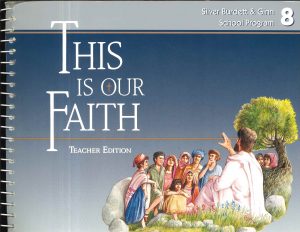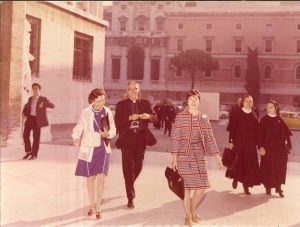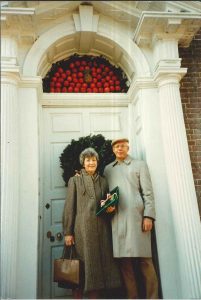
Guest author Tricia Campbell Bailey is a graduate of the Catholic U. Library and Information Science (LIS) Department.
Before I returned to school to become an archivist, I spent 20 years as a journalist and corporate communications specialist. Much of that time was spent on science and technology writing; I quickly learned how to break down technical information clearly and how to find the “hook” that lurks in every story beneath the technical details and scientific jargon. In fact, the most important lesson I learned as a writer was: There’s no such thing as a boring assignment.
Happily, when I took on my first archival project as a CUA graduate student, I learned that that lesson applied to archival work, as well. And last month, when I returned to CUA as a part-time archives assistant, I discovered it all over again. Every boxful of papers and every crumpled photograph tells a story. On the surface, this story is about two religious educators and business owners — but it’s also about faith, love, and living life on one’s own terms.
The collection, newly acquired by the Catholic University Archives, is the personal papers of Janaan Manternach and Carl Pfeifer, who revolutionized Catholic education for children beginning in the 1960s. Together they wrote multiple religious education textbooks and curricula, along with many columns, books, and articles about the best way to teach children about the Catholic faith.
Revamping the Catechism
Until the 1960s, religious instruction in the U.S. was based on the Baltimore Catechism, which used a rote question-and-answer format that many children found difficult to engage with. However, many Catholics today learn about their faith very differently — largely due to Manternach and Pfeifer’s work.
In the late 1950s, the National Confraternity of Christian Doctrine (CCD) Center became aware of Sister Mary Janaan (born Shirley Marie Manternach), a young Franciscan sister from Dubuque, Iowa who incorporated poetry, art, and music into her religion class at an inner-city Chicago school. In 1960, she was reassigned to Washington, D.C. to study Religious Education at The Catholic University of America — and to work with CCD Director Rev. Joseph Collins on a textbook series to replace the Baltimore Catechism.

Three years later, in a graduate class at CUA, Sister Mary Janaan met Father Carl Pfeifer, a young Jesuit priest and teacher from St. Louis. He shared her interest in making religious education more accessible to children, and she eventually proposed to the CCD Center that he be assigned to work with her on the textbook project. This sparked a professional and personal partnership that was to last for more than 40 years.
“I Could Not Live Without Him”
From 1963 to 1975, Sr. Manternach and Fr. Pfeifer were co-assistant directors of the CCD Center, where they not only authored the Life, Love, Joy textbook series but also represented the Center to diocesan directors nationwide; consulted for various Church religious education groups; and were instrumental in the creation of the National Conference of Diocesan Directors (NCDD). In 1975, they left to form their own freelance writing business, also called Life, Love, Joy.
Together, they traveled to dioceses across the country introducing the series and training catechists. For example, notes from Manternach’s notebook point to her love of using art and music in her teaching, and to finding ways to engage children through stories: “The Bible’s not enough! Generate spinoffs – poetry – music – story – art/culture rises up around it – multiple tellings.”
But by this time, they were discovering something else — their successful professional partnership was becoming something more. In 1976, both Sr. Manternach and Fr. Pfeifer requested and received permission to be released from their vows, and they were married on November 20, 1976. In her personal writings from the early 1980s, Manternach notes candidly, “I decided to marry him because gradually I became aware that I could not live without him.”
Leaving religious life caused some temporary backlash against the two in the Church, but their success as catechists and devotion to their work earned them forgiveness, and they continued to be influential in the religious education movement even as laypeople.

A Life of Love and Joy
In addition to the Life, Love, Joy series, which was revised many times (it was later known as the Silver Burdett Religion Program, Growing in Faith, and finally This is Our Faith), the couple wrote syndicated columns for many Catholic publications and traveled extensively to present workshops and lectures. In 1985, both Pfeifer and Manternach received their Doctor of Ministry degrees from St. Mary’s Seminary and University in Baltimore.
Far beyond their passion for their work, however, the collection’s extensive amount of correspondence reveals the human side of the couple. An entire box of the collection is reserved for Manternach and Pfeifer’s holiday newsletters, which they circulated to their wide-ranging circle of friends and family at Christmas and Easter. Despite the initial controversy around their transition from religious life, two bulging folders contain well-wishes for their 1976 wedding. Both stayed in regular touch with their families in the Midwest. And although they were unable to have children of their own, they doted on their four godchildren. Extensive correspondence from the early 2000s shows that Manternach and her goddaughter Angela communicated almost daily, often through multi-page handwritten letters and photo collages.
In the early 2000s, Pfeifer was diagnosed with Alzheimer’s Disease, and he and Manternach returned to Manternach’s home state of Iowa to care for him and for her elderly mother. Pfeifer died of complications from Alzheimer’s in 2007; Manternach, now in her 90s, lives on her own in Dubuque, about 25 miles from her hometown of Cascade. She remains active as an author; most recently she published I’d Do it All Over Again and I’d Do it Better: A Caregiver’s Journey through Alzheimer’s (ACTA Publications, 2020).
The Manternach/Pfeifer collection has not yet been fully processed, but work is underway and a full online finding aid will be available. This collection is a rare glimpse into two people who spent decades passionate and joyful about their faith — and about one another. Their lives and work can best be summed by a quote from Manternach found scrawled in a notebook with other thoughts on catechesis: “Hope is part of the structure of most of our existence.”
Works Cited
Manternach, D. (n.d.). Janaan Manternach and Carl J. Pfeifer. Biola University. Retrieved February 18, 2021, from https://www.biola.edu/talbot/ce20/database/janaan-manternach-carl-pfeifer
Carl Pfeifer Obituary, 1929-2007. (2007, July 15). The Washington Post. https://www.legacy.com/amp/obituaries/washingtonpost/90699372
